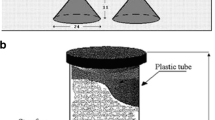Abstract
Soil gas pollutants (VOCs, radon, …) have long been known to intrude into buildings through various openings, e.g., cracks and gaps in the foundations. As yet no model has been developed which can quantify this rate of flow whilst taking into account various substructure configurations. This is due to the complex phenomena that need to be consider and particularly to the difficulty in estimating pollutant flows at soil-building interfaces. In this paper analytical models have been developed to quantify these flows. The models have been developed for some typical substructure configurations: slab-on-grade, basement and crawlspace. The inputs of these models include particularly the foundation wall depth and the slab permeability. The analytical models have been compared to existing analytical models for one of the configurations. Moreover a 2-D finite element model has been used for numerical comparison. The models are presented as pressure-flow relationships and can be integrated into risk assessment tools in order to study the impact of soil gas pollutants on indoor air quality.
Similar content being viewed by others
References
Abdelouhab M, Collignan B, Allard F (2010). Analytical and numerical quantification of air flows through the ground to study the impact of gaseous soil pollutants on indoor air, first results. In: Proceedings of CLIMA2010: 10th REHVA World Congress: Sustainable Energy Use in Building, Antalya, Turkey.
Aldenkamp FJ, Stoop P (1994). Sources and transport of indoor radon: Measurements and mechanisms. PhD Thesis, University of Groningen, the Netherlands.
Andersen CE (1992). Entry of soil gas and radon entry into houses. PhD Thesis, Technical University of Denmark, Denmark.
Andrade C, Sagrera JL, Martinez I, Garcia M, Zuloaga P (2003). Monitoring of concrete permeability, carbonation and corrosion rates in the concrete of the containers of El Cabril (Spain) Disposal. Transactions of the 17th International Conference on Structural Mechanics in Reactor Technology (SMiRT 17). Prague, Czech Republic.
Brinkman HC (1947). A calculation of the viscous force exerted by a flowing fluid on a dense swarm particles. Applied Science Research, Section A1: 27–34.
Denarié E, Maître M, Conciatori D, Brühwiler E (2005). Air permeability measurements for the assessment of the in situ permeability of cover concrete. In: Proceedings of ICCRRR 2005, Cape Town, South Africa.
DeVaull GE (2010). Vapor intrusion from subsurface to indoor air: biodegradable petroleum vapors versus recalcitrant chemicals. Paper presented at Air and Waste Management Association (A&WMA) Specialty Conference, Chicago, Chicago, USA.
Garbesi K, Sextro RG (1993). Soil-gas entry into an experimental basement: model measurement comparisons and seasonal effects. Environmental Science and Technology, 27: 466–473.
Hintinlang DE, Al-Ahmandy KK (1992). Pressure difference for a radon entry coupled to periodic atmospheric pressure variations. Indoor Air, 2: 208–215.
Janssen PHM, de Vries L, Phaff JC, van der Graaf ER, Blauuboer RO, Stoop P, Lembrechts J (1998). Modeling radon trasport in Duch dwellings. Bilthoven, the Netherlands: National Institute for Public Health and the Environment (RIVM). RIVM report no. 610050005.
Jergling A (1981). Air leakage through cracks in concrete elements. Chalmers University of Technology/Division of Structural Design, Sweden.
Johnson PC, Ettinger RA (1991). Heuristic model for predicting the intrusion rate of contaminant vapors into buildings. Environmental Science & Technology, 25: 1445–1452.
Krylov VV, Fergusson CC (1998). Contamination of indoor air by toxic soil vapours: The effects of subfloor ventilation and other protective measures. Building and Environment, 33: 331–347.
Martys N (2001). Improved approximation of the brinkman equation using a lattice Boltzmann method. Physics of Fluids, 13: 1807–1810.
Mowris RJ (1886). Analytical and numerical models for estimation the effect of exhaust ventilation on radon entry in houses with basement or crawl spaces. Berkeley, CA: Lawrence Berkeley Laboratory. Report No. LBL-22067.
Mowris RJ, Fisk WJ (1988). Modelling the effects on exhaust ventilation on 222Rn entry rates and indoor 22Rn concentrations. Health Physics, 54: 491–501.
Nazaroff WW (1988). Predicting the rate of 222Rn entry from soil into basement of a dwelling due to pressure-driven air flow. Radiation Protection Dosimetry, 24: 199–202.
Nazaroff WW (1992). Radon transport from soil to air. Reviews of Geophysics, 30: 137–160.
Nazaroff WW, Feustel H, Nero AV, Revzan KL, Grimsrud DT (1985). Radon transport into a detached one-story house with basement. Atmospheric Environment, 19: 31–46.
Nazaroff WW, Lewis SR, Doyle SM, Moed BA, Nero AV (1987). Experiments on pollutant transport from soil into residential basements by pressure-driven airflow. Environmental Science & Technology, 21: 459–466.
Olson DA, Corsi RL (2001). Characterizing exposure to chemicals from soil vapor intrusion using a two-compartment model. Atmospheric Environment, 35: 4201–4209.
Provoost J, Bosman A, Reijnders L, Bronders J, Touchant K, Swartjes F (2010). Vapor intrusion from the vadose zone—Seven algorithms compared. Journal of Soils Sediments, 10: 473–483.
Put LW, de Meijer RJ (1989). Air pressure differences in and around residences: Implications for the transport of radon. Kernfysish Versneller Institut, Universiteit Groningen, the Netherlands. (in Dutch)
Robinson AL, Sextro RG (1995). Direct measurements of soil-gas entry into an experimental basement driven by atmospheric pressure fluctuations. Lawrence Berkeley Laboratory, University California, Energy and Environment Division, USA.
Scott AG, Findlay WO (1983). Demonstration of remedial techniques against radon houses on Florida phosphate lands. Montgomery, USA: U.S. Environmental Protection Agency, Office of Radiation Programs, Eastern Environmental Radiation Facility. Report No. EPA 520/5-83-009.
Sunderland JE, Johnson KR (1964). Shape factors for heat conduction through bodies with isothermal or convective boundary conditions. ASHRAE Transactions, 70: 237–241.
US-EPA (2004). Users Guide for Evaluating Subsurface Vapor Intrusion into Buildings.
Waitz MFW, Feijer JI, Kreul P, Swartjes FA (1996). The VOLASOIL risk assessment model based on CSOIL for soil contaminated with volatile compounds. Bithoven, the Netherlands: National Institute for Public Health and the environment (RIVM). RIVM report no. 715810014.
Yao Y, Shen R, Pennell KG, Suuberg EM (2011). Comparison of the johnson-ettinger vapor intrusion screening model with full three dimensional model results. Environmental Science & Technology, 45: 2227–2235.
Author information
Authors and Affiliations
Corresponding author
Rights and permissions
About this article
Cite this article
Diallo, T.M.O., Collignan, B. & Allard, F. Analytical quantification of airflows from soil through building substructures. Build. Simul. 6, 81–94 (2013). https://doi.org/10.1007/s12273-012-0095-2
Received:
Revised:
Accepted:
Published:
Issue Date:
DOI: https://doi.org/10.1007/s12273-012-0095-2



